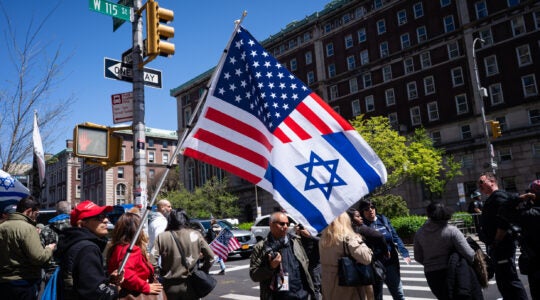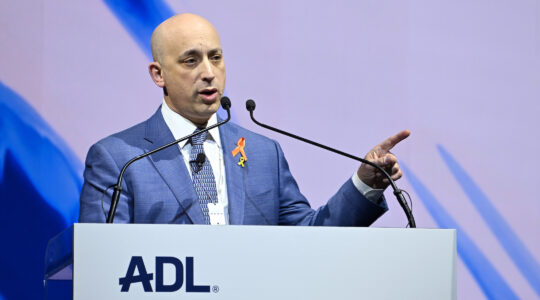
Tribute in Light. September 11, 2010. (Robert. A Cumins)
NEW YORK (JTA) — It was an ominous hum.
A dozen refrigerated trucks loaded with the body parts of victims of the 9/11 attacks filled a cavernous tent across the street from the Office of the City Medical Examiner, their low-pitched buzz an eerie soundtrack to the solemn work being carried out at the morgue about 3 miles north of Ground Zero.
While rescue workers downtown searched through the wreckage of the World Trade Center for human remains, forensic experts at the medical examiner’s office carefully analyzed and catalogued their finds, preserving every piece of flesh and bone in an effort to identify them and eventually return them to victims’ families.
Occasionally an ambulance would pull up to the cordoned-off street and the bustle would come to a halt while rescue workers unloaded a flag-draped box filled with newly discovered remains.
For more than seven months after the attacks on Sept. 11, 2001, this somber place in downtown New York filled with firefighters, police officers, construction workers and clergymen had another fixture: Jewish volunteers who came one by one to take part in a round-the-clock prayer vigil at the morgue, where they spent four-hour shifts reciting Psalms.
The vigil was part of the Jewish ritual of shmira, escorting the dead from the time of passing until burial — a period that normally lasts no longer than 24 to 48 hours. In the case of the victims of the Trade Center attacks, a quick burial clearly was not possible, so the prolonged shmira watch was born. It ran without pause 24 hours a day, seven days a week, from Sept. 20, 2001 until April 30, 2002.
The body parts in the trucks weren’t exclusively those of Jews, but because Jewish remains were assumed to be among them, shmira was necessary.
Volunteers mostly spent their time sitting in a trailer filled with a few stray prayerbooks, lukewarm coffee and folding chairs for relief workers who cycled in and out during brief breaks from 12- and 16-hour shifts at Ground Zero. Some recited Psalms for the dead inside the tent with the refrigerated remains, taking the admonition to escort the dead to the grave as literally as possible.
The tent was filled with the smell of antiseptic and death. Each of the plain white trucks was draped with an American flag. Bouquets of plastic red, white and blue flowers would be added later to the foot of each truck, alongside photographs of some of the victims and a few votive candles. A huge American flag hung from the tent’s roof.
Outside, two expansive plywood walls had been turned into a makeshift memorial. They were covered with appreciative messages and weather-stained photographs of victims and their families sent in from all over America.
One rain-soaked night in the relief trailer where the Psalters were kept, a man wearing scrubs struggled to choke back tears.
“Look at what they’ve done to our people,” he said, his voice shaking. “I know you’re men of faith, but I want vengeance.”
Even in the pouring rain at 4 in the morning, the site where the dead where kept bustled with activity. Police officers and state troopers stood guard while police, firefighters, FBI agents and other officials made their way in and out of the cordoned-off area. Volunteers coming for the shmira watch would pick up clergy tags from the previous volunteer before entering.
Armin Osgood, a soft-spoken, portly, bearded man from an Orthodox synagogue on Manhattan’s Upper West Side, Ohab Zedek, coordinated the shmira watch, and many of the volunteers came from his congregation.
But on Shabbat, when the volunteers — who came from as far as New Jersey and Pennsylvania — couldn’t take trains or taxis to reach the site, students from Yeshiva University’s Stern College for Women, which was within walking distance of the morgue at 30th Street and First Avenue, managed the vigil. Their effort was written up in The New York Times.
The Rev. Betsee Parker, an Episcopalian chaplain who was a constant presence at the morgue site, later wrote about the shmira watch in a chapter in the book “Holy Tears: Weeping in the Religious Imagination.” The chapter was titled “‘Send Thou Me’: God’s Weeping and the Sanctification of Ground Zero.”
A year to the day after the Hebrew anniversary of the attacks — on the victims’ first yahrzeit — many of the people who had participated in the shmira gathered again at the morgue. This time they came together for the first night of recitation of Selichot, the annual Jewish ritual of reciting special late-night penitential prayers in the days leading up to the High Holidays. The night had happened to fall on 9/11’s first Hebrew anniversary.
“It was one of the most meaningful Selichot services I’ve ever attended,” Osgood said after the service. “I was never so moved by just being there. I had been in that tented area before, where the trucks were parked. Even with the refrigeration and whatever attempts they’ve made to preserve the bodies, there’s an aroma there. I felt the presence of the neshamas there” — the departed souls. “I felt everything.”
After the service, the participants lingered to recite the entire Book of Psalms, divvying up the chapters so the entire book could be read in just a few minutes.
Parker, who is known as Rev. Betsee, had come for the Orthodox service, and she too read some of the Tehillim, or Psalms.
“If God could accept the recitations in poor Hebrew of a goy, we managed to get through the whole book of Tehillim with one rusty goy,” she said. “It was a very elegant mitzvah for God. I knew that Adonai was delighted with what we had done there. I could feel that in my soul.”
Another shmira veteran who had come for the Selichot service, Ely Razin, spoke in a hushed tone after the service was over.
“It’s funny,” Razin said. “People forget about what happened, and then you come down here and it’s like a different world. It’s like it just happened yesterday.”
JTA has documented Jewish history in real-time for over a century. Keep our journalism strong by joining us in supporting independent, award-winning reporting.





